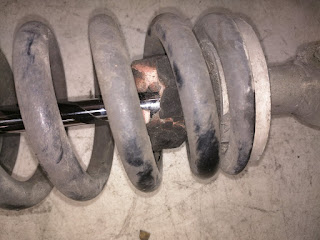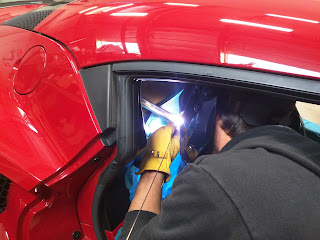 |
| Standard bump stop on a Nitron 40mm Single Adjustable Shock |
The bump stop prevents damage by absorbing and dissipating a huge amount of force when your suspension bottoms out. If the bump stop was not present, a large (and harsh) impact force would be transferred into the chassis and into the lower suspension arm. In this scenario, the chassis and/or the a-arm can be damaged. In other words, not good. You can have a bottom out condition without damage but it is still highly stressful to all the components and passengers involved.
The second, and more subtle job of the bump stop is to be progressive. When the car is normally going around a track, the suspension is working with what ever spring rate you are running (resulting in some wheel rate). When you run out of travel and fully collapse a shock with no bump stop, your spring rate (and therefore wheel rate) goes to infinity. Infinity is a very high spring rate indeed and is the least compliant you can get. Tires do not like to stick to the ground when there is no compliance. This situation does nothing good for handling. When a bump stop is in place, rather than an immediate spring rate to infinity transition; there will be a progressive ramping up of the spring rate. This is much more forgiving on the suspension and chassis and results in much more predictable handling.
Bump stops do wear out over time. The life is going to be determined mainly by the environment in which they live. Severe weather and track use will accelerate degradation and wear. Miles are pretty much irrelevant unless your car is "stanced bro" and you are riding on the bumpstops constantly. Evidence of this can be seen on a car we currently have in the shop. It is a 2006 Lotus Elise with 14,000 miles on it. Luckily this customer is getting a nice set of Nitron 40mm Single Adjustable Dampers to replace these tired units.
 |
| This is not an effective bump stop... |

